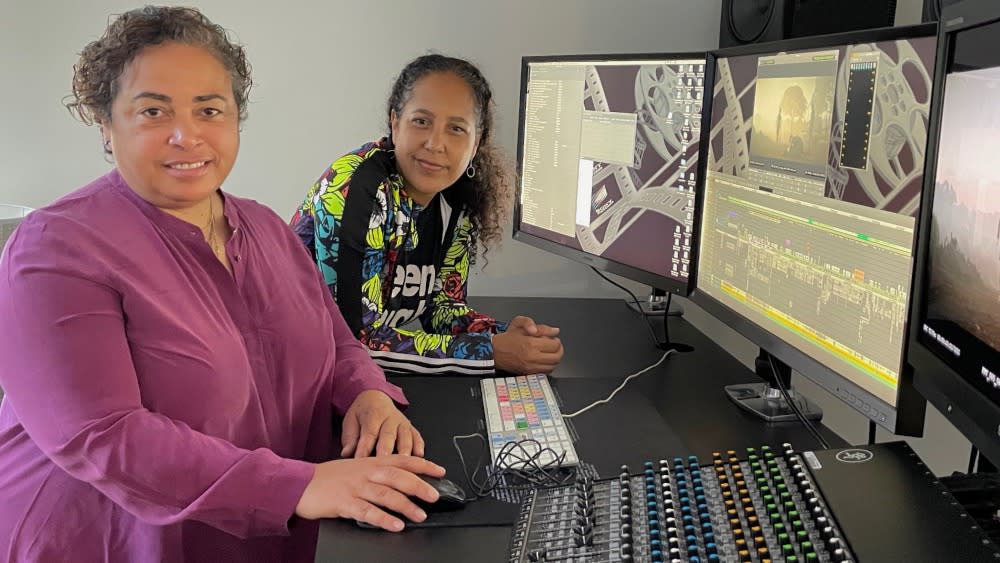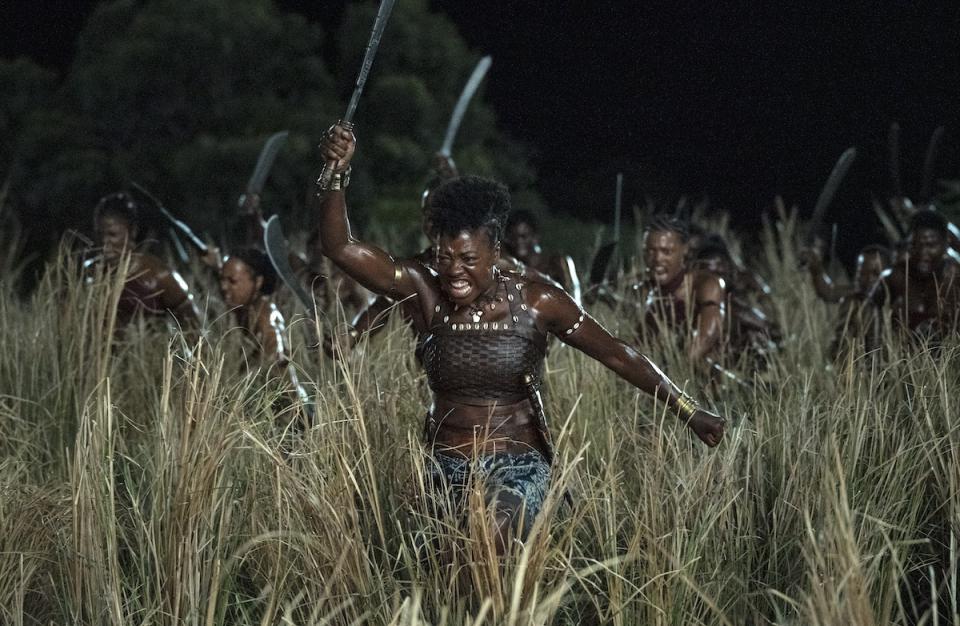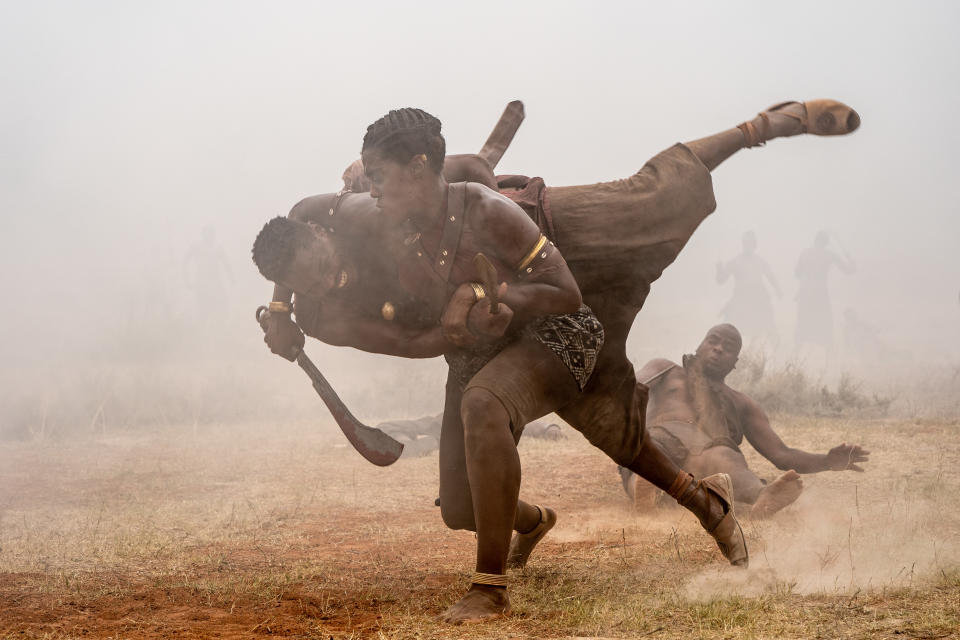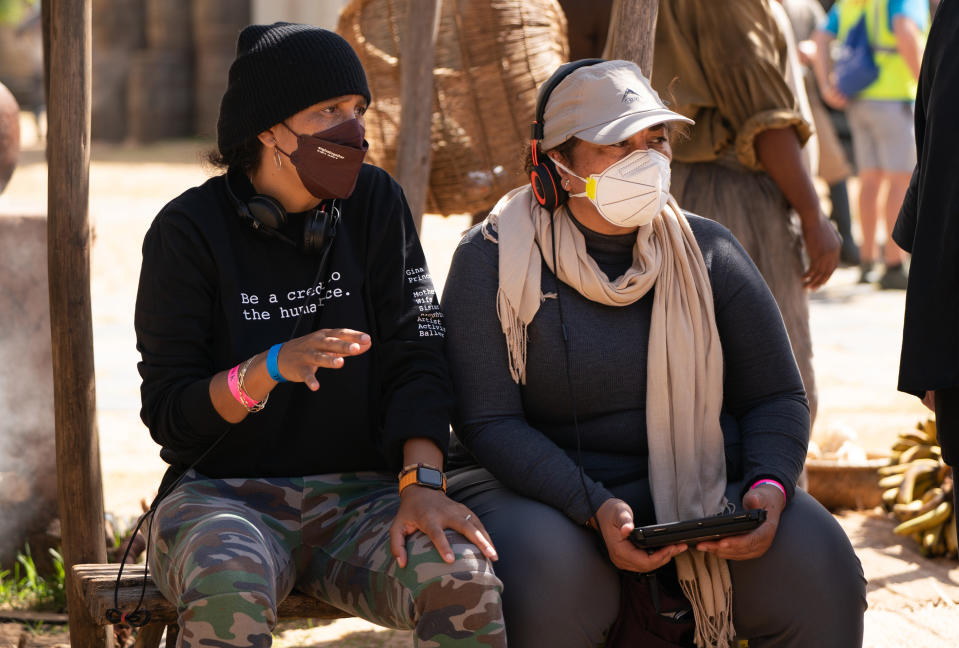Gina Prince-Bythewood & Editor Terilyn Shropshire

Less than two weeks before “The Woman King” was set to premiere at the Toronto International Film Festival, its director and editor were in a post-production facility in Sherman Oaks still fine tuning the action-packed epic. It was the final days of director Gina Prince-Bythewood’s years-long journey to bring the story of the Agojie, a group of women warriors in 19th century Africa, to the big screen. The pressure was high, but the mood was calm and relaxed. While not always agreeing, the two collaborators were in sync, their process methodical and precise in making what can feel like an endless series of decisions and tweaks. As Shropshire told IndieWire at the time, “We don’t need any drama in the room. We keep that on the screen.”
There was plenty of drama, both onscreen and off, when it came to “The Woman King.” “It was the hardest shoot I’ve had in my career,” Prince-Bythewood told IndieWire. It was a battle just getting to make the film, which several studios rejected as a risky proposition before Prince-Bythewood, Viola Davis, and their producing partners convinced Sony to finance it. The director was constantly required to defend her choices, like eschewing green screen in favor of a location shoot — the former would’ve been logistically easier and more controllable, but Prince-Bythewood has always put a premium on the authentic and wanted the audience and cast to experience their real surroundings in 360 degrees. “The vision of this movie was not always recognized by others, and I was not getting the feedback that I normally get when I’m shooting,” she said.
More from IndieWire
By the time the time she found herself in South Africa surrounded by armies of actors and extras, along with the hundreds of crew members required to mount a movie of this size, Prince-Bythewood often felt as though she stood alone at the center of a maelstrom. Luckily, she had a life raft in the storm. “Thank God Teri was there,” the director said. “She was that voice saying ‘What you’re shooting is good. What you’re shooting is what you had said you were going to do.’ And I needed that on this one.” Although Prince-Bythewood had directed full-blown action scenes in the Netflix comic-book adaptation “The Old Guard,” “The Woman King” posed new challenges. On “The Old Guard,” she had five days to shoot an airplane fight between Charlize Theron and Kiki Layne; for “The Woman King,” she was given a little over twice that amount of time for the most complicated sequence she’d ever directed. “We had 11 days to shoot the whole battle with hundreds and hundreds of people fighting,” she said. “It was scary, and it was a ton of footage.”
In midst of this kinetic clash, there are several small, self-contained interactions between characters that pay off individual stories of women of different generations and experience coming together. In a film about sisterhood, grounding these moments in the characters’ relationships and growth gives the action its emotion and resonance. Unlike the common style of today’s serialized blockbusters, “The Woman King” doesn’t pause for quips or character asides. Prince-Bythewood’s direction keeps her characters’ stories engrained in the physical action itself.

Looking at the sequence through the lens of these personal dynamics , there’s a direct parallel to the concluding action of her first film, “Love & Basketball,” in which the romantic tensions between Monica (Sanaa Lathan) and Quincy (Omar Epps) are resolved in a high-stakes game of one-on-one. It’s also the scene Prince-Bythewood uses to illustrate the direct impact Shropshire has had on her filmmaking.
Shropshire was recommended to the rookie director by Spike Lee, following her work on Kasi Lemmons’ “Eve’s Bayou.” Prince-Bythewood admits that at the time she had hoped to work with a more seasoned editor, but in describing how the one-on-one scene came together, it becomes clear how fortunate she was not to get her wish. “I don’t like watching cut footage when I’m shooting, it freaks me out,” recalled the director. “But [Teri] forced me to and said, ‘I think you’re missing some emotional beats.’”
Shropshire had picked up on Prince-Bythewood’s passion for authenticity in the action. After watching Shropshire’s early cut of the one-on-one game, and listening to her suggestions, the director went back and shot another night of small pieces: “the looks between them, closeups of moments like her slapping the ball away or grabbing herself or pulling off her shirt. Just the little things that helped build the emotion of the scene.” The results represented a technique of synthesizing gestures, psychology, and action — what the two collaborators have come to refer to as their goal of being “intimately epic” — that reaches its apotheosis in “The Woman King.”
To watch Monica and Quincy’s one-on-one scene, and for more on how “Love & Basketball” laid the groundwork for the “intimately epic” action of “The Woman King,” watch the video below.
Prince-Bythewood’s ability to stay focused on the big picture without losing sight of the many specific textures and gestures that give the “Woman King” battle its heart is key to the film’s greatness — but this was a difficult task due to the complexities of the production, which entailed everything from pandemic setbacks to tense studio negotiations to managing multiple units and covering the action with several cameras. It’s here that the director leaned on Shropshire, having first talked through the plan ahead of time; during production, Shropshire served as a safeguard, assuring Prince-Bythewood that she was getting what they needed to deliver on it. “I think it’s really important when you can help a filmmaker get through those times,” Shropshire said. “There’s so much noise during production and you try really hard in the editing room to keep that noise out and just say, ‘Keep going. You got this.’”
From Prince-Bythewood’s perspective, the big action scenes were made more manageable by breaking them down into moments that said something about the characters, a method Shropshire adopted as well. “You have to do it in waves,” she said, “otherwise you’ll just become overwhelmed. I used to have this big sign in my editing room with one word – ‘Begin’ – because as things come in I could go here, I could go here, I could start here. And it’s like, ‘Okay let’s just start someplace.’” Prince-Bythewood worked with stunt coordinator Danny Hernandez to find all the personal stories within the battles and express those through action. “It can’t just be a bunch of people fighting, because after a while, who cares?” Prince-Bythewood said.
Prince-Bythewood’s character-driven approach to action yields dozens of powerful moments as dramatically satisfying as they are kinetically thrilling, as when Amenza (Sheila Atim) and Izogie (Lashana Lynch) join forces at a crucial moment to kill an enemy soldier. When they quickly come together, dispatch their nemesis in an elegantly choreographed ballet of violence, and then just as quickly separate to return to other sections of the battlefield, it’s a visceral, cinematic representation of the film’s celebration of sisterhood delivered via a series of compact, expressive images.

Although Prince-Bythewood meticulously laid out the action of the battle sequences using classic adventure films like “Braveheart” and “The Last of the Mohicans” as reference points, the sheer quantity of footage combined with the complexity of editing elaborately choreographed action put Shropshire under abnormal pressure. “What was crazy about this film was that the schedule for me to deliver my cut to Gina was the same schedule I would have had on something small like ‘Secret Life of Bees,’” Shropshire said. “I had first and second unit shooting simultaneously, so on any given day it was enough just to watch the footage. By the time I watched all the dailies, the day was over. But Gina gave me the time to finish, to get it to a point where she could look at it and not be miserable. And that’s because of our relationship, because there would be directors who would say, ‘I want to get in right now, I want to start working.’”
Shropshire took the extra time she needed to get the movie to a place where Prince-Bythewood would be able to more productively process it — and where Shropshire would feel secure showing it to her. “I don’t care whether you’ve worked together for five minutes or 20 years, the most daunting thing is showing your cut to the director for the first time,” Shropshire said. “Because they have something in their head. They have a vision. They’re just coming off set. They remember every day when the generator went down, when they lost a day to COVID or the weather. They’re still in that head space, and you’re about to say, ‘Here, this is what my foundation of your film is.”
Watch the video below to see how the big battle sequence from “The Woman King” came together.
Watching Prince-Bythewood and Shropshire at work, it quickly becomes clear that while they’re relaxed under pressure, there’s a relentless striving toward greatness and a refusal to be satisfied constantly humming beneath the surface — something that both filmmakers acknowledge can lead to heated disagreements. Yet one of their many talents is channeling those disagreements toward the good of the film, something “Love & Basketball” and “The Woman King” composer Terence Blanchard has witnessed firsthand. “What makes them special is that they’re open to dialogue,” Blanchard said. “They’re open to any suggestion — just prove your point. Make your argument.” According to Prince-Bythewood, the secret is that Shropshire isn’t precious about her own work. Because of that, “We can fight and it’s always about the film. It never gets personal. She will call me on things in a good way. I cannot speak enough on how important that trust is.”
For Shropshire, Prince-Bythewood’s role as a “technician of truth,” is vital to the relationship. Shropshire recalled the director’s obsession with realism started from their first days on “Love & Basketball.” “I’d cut a version of a game where there might be four or five bounces before [Monica] takes a shot. If that fifth bounce was not technically [correct], Gina was like, ‘We can’t use it. We’ve got to find a different way.’” By the same token, when Prince-Bythewood had something physically down but Shropshire felt it was missing something emotionally, the editor could say so and together they would dig in and make sure each scene had everything that it needed.
Since then, the trust has built to the point that Shropshire is Prince-Bythewood’s most valued and constant collaborator from the beginning of the process through the final mix. Whenever she has a new script, the first person to read it is her husband, fellow writer, producer, and director Reggie Rock Bythewood. The second person is Shropshire. From that point forward, Shropshire is closely involved with every decision.
“I’m old school,” she said. “I came up with film in cutting rooms where the editor was the head of the department, and being head of post-production meant that you were on through the end. You were there through the final mix, you were there until you saw the final print of the film. Digital technology has kind of changed the role, but to me the role remains the same: from the first frame of film that comes into my room to the last frame I see in the DI, it’s my responsibility to make sure that it’s continuing to be elevated.”

Prince-Bythewood said that she often hears Shropshire’s voice in her head while she’s shooting, telling her that she needs to make sure she gets a certain shot when she’s running out of time, but the telepathic communication works both ways. “After so many years of working together, I know what she’s looking for in a particular scene,” Shropshire said. “Even when we’re not in the same space — when she’s on set and I’m in the editing room — you still hear the voice of the artist you work with, and the more you get to know them the more you get a sense of what’s going to work for them and what’s not. I think that’s something that comes with time and patience and just getting to know who each other is as an artist.”
From “Love & Basketball” to “The Woman King,” Shropshire feels that one thing hasn’t changed. “Gina is always seeking and moving toward the truth of a character, whether it’s manifested physically or emotionally,” she said. The same goes for Shropshire’s initial way of responding to the footage. “I just look for what I want to see as an audience member,” she said. “I don’t like to take notes the first time I watch dailies, because I want to keep that initial feeling of what it felt like the first time you saw it. When I have those moments where I can just allow myself to watch the film, that’s my most quiet, precious time in the cutting room.”
On “The Woman King,” it was sometimes difficult to keep that level of calm, which makes the seamlessness and power of the finished product all the more impressive. “Even in the room, you’re always putting out fires,” Shropshire said. “You’re trying to cut, but you’re also trying to make sure that if the studio has concerns about things you’re a step ahead of it and able to help show, ‘Look, we’re good here, this is going to be fine.’ You just try to keep everybody in a calm place.”
“It’s a really scary thing,” Prince-Bythewood added. “When you’re directing, you have your gut, but you don’t really know [what you have] until you start putting the film together. And the thing that scares me the most is that nobody sets out to make a bad movie. There are great filmmakers who have had missteps. To have Teri be a constant refrain in my head is really helpful.”—Jim Hemphill
Best of IndieWire
The Best Survival Movies, from ‘Cast Away’ and ‘The Revenant’ to ‘The Martian’ and ‘Alive’
The 20 Best Spy Movies, from 'Enemy of the State' to 'North by Northwest'
Sign up for Indiewire's Newsletter. For the latest news, follow us on Facebook, Twitter, and Instagram.

 Yahoo News
Yahoo News 
